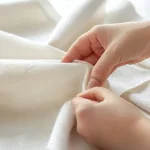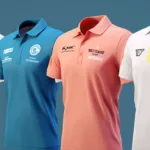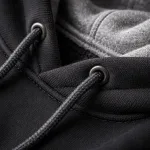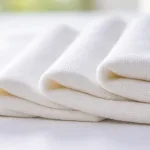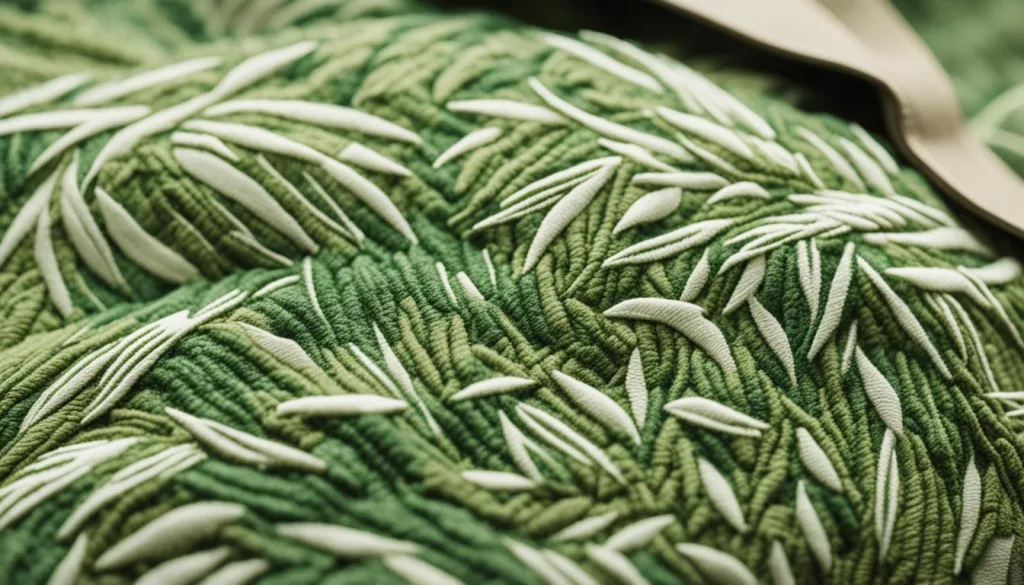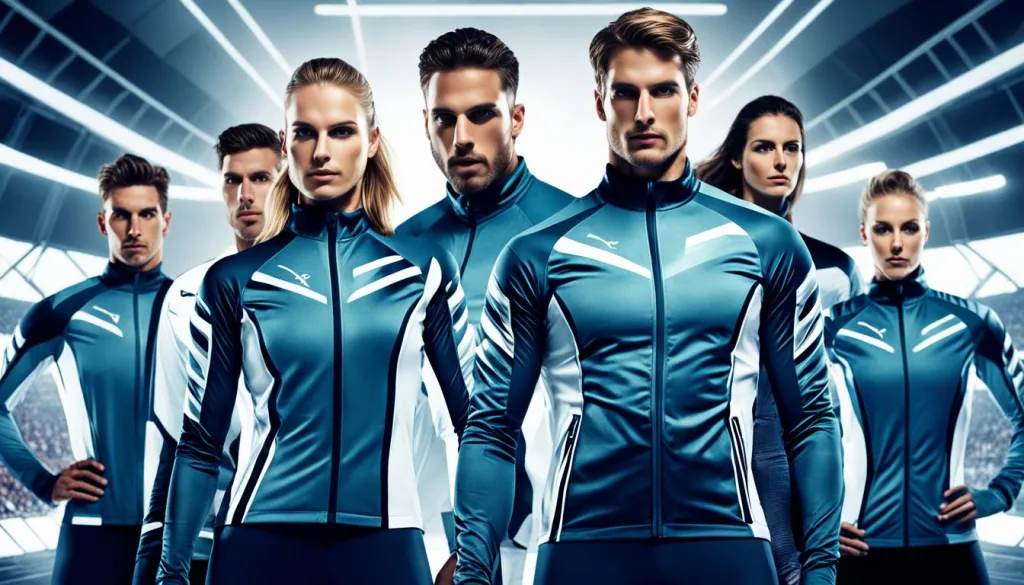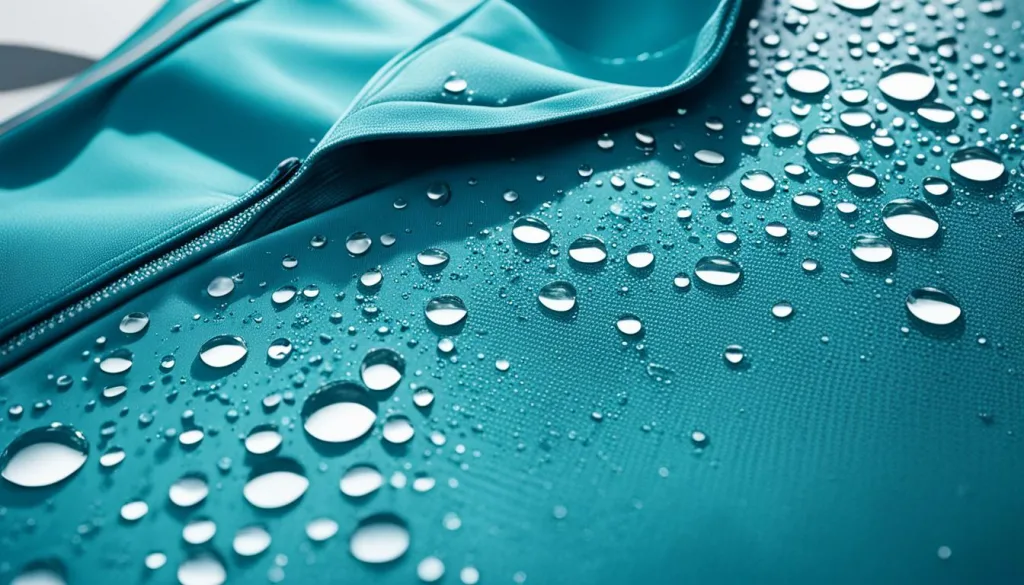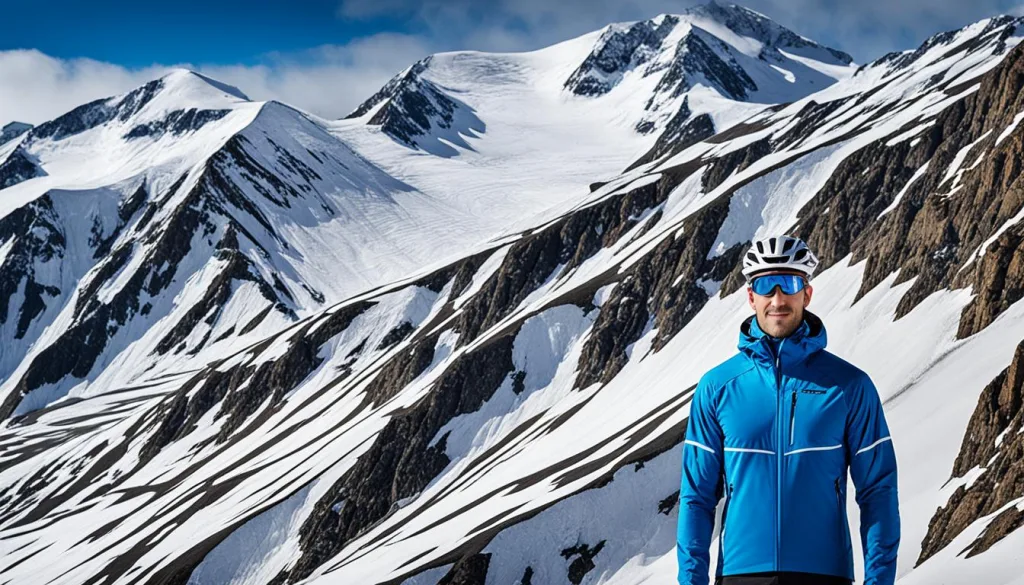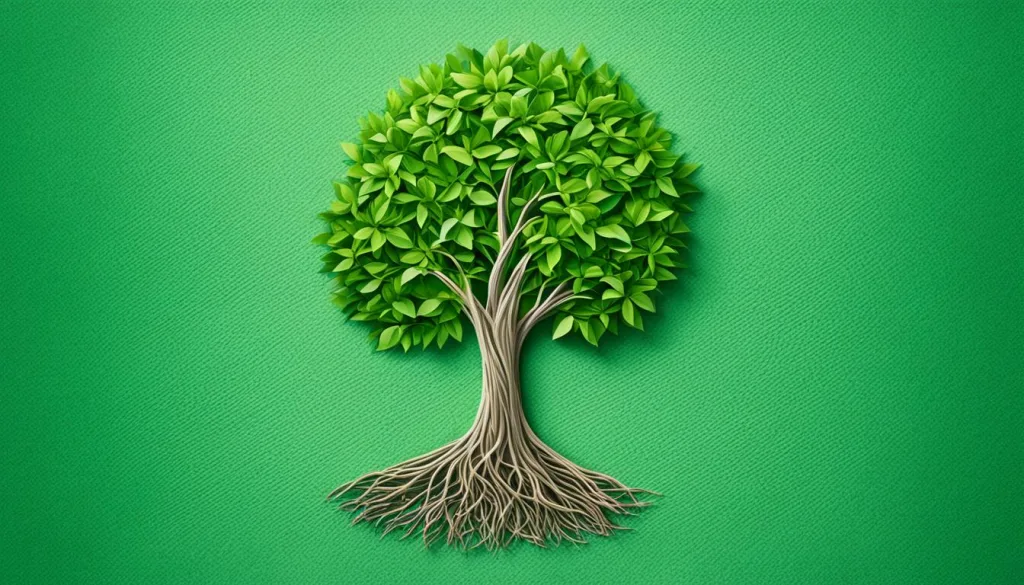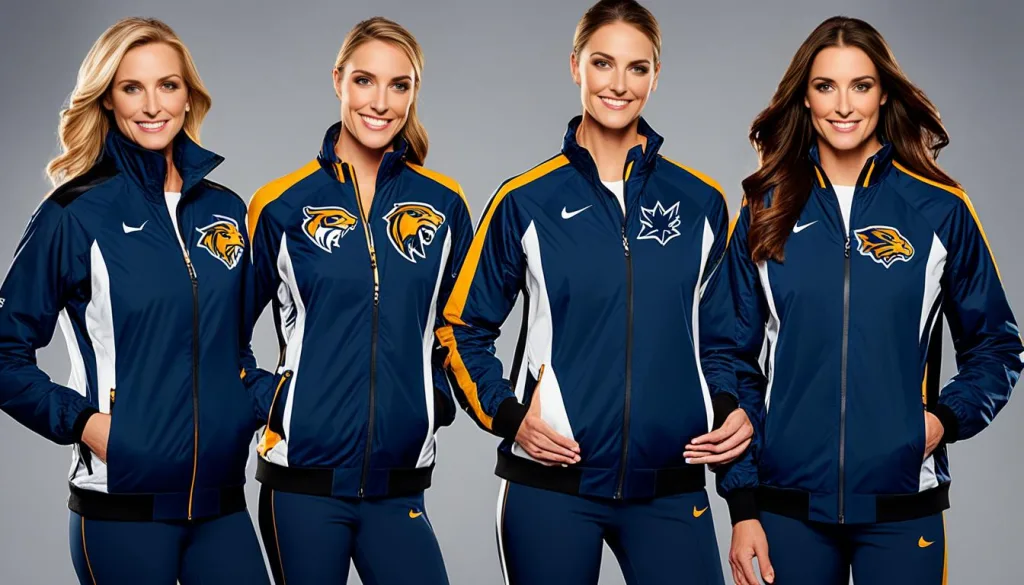Team Jackets Materials come in many different materials today. We have traditional varsity looks and high-tech fabrics. These options mix style with function for athletes and fans.
Varsity jackets often use cowhide leather, which is durable and classic1. If you’re looking for something more affordable and ethical, faux leather is a great choice1. Wool is perfect for cold weather, keeping you dry1.
Polyester is the go-to for team wear, known for its strength2. Nylon is also tough and great for active wear2. Jackets needing to stretch might include spandex for flexibility2.
The lining of a jacket is key for comfort. You can choose from cotton, polyester satin, or quilted linings13. Polyester linings are popular because they’re cheap and come in many colors3.
New options like bamboo fiber are becoming popular for sportswear2. They are light and wick moisture, keeping athletes comfortable. The fabric you pick affects a jacket’s breathability and how it manages sweat.
Key Takeaways
- Leather and wool are traditional choices for durability and weather resistance
- Polyester dominates synthetic materials for its versatility and affordability
- Nylon and spandex enhance durability and flexibility in activewear
- Lining materials play a crucial role in comfort and functionality
- Innovative fabrics like bamboo are emerging for enhanced performance
- Material selection impacts breathability, moisture-wicking, and overall comfort
Understanding the Importance of Fabric Selection for Team Jackets
Choosing the right fabric for team jackets is key. It affects how players perform and feel. The choice impacts comfort, durability, and style. This is why it matters so much.
Impact on Performance and Comfort
Certain jacket fabrics help athletes perform better. Cotton makes light, cool jackets great for spring and summer4. Wool keeps you warm, making it great for winter4. Polyester helps keep jackets durable and water-resistant for outdoor sports45.
Balancing Aesthetics and Functionality
Team jackets must both look good and perform well. Fabric is a big part of a jacket’s cost. Choose wisely6. Knits are comfy and let you breathe. Wovens are strong and resist tears6. Designers can choose weaves, colors, and textures at many factories4.
Considering Climate and Sport-Specific Requirements
Every sport and weather has fabric needs. Wick-away fabrics are musts for intense sports. Fleece is soft, warm, and breathes in the cold5. Shearling is unbeatable for extreme colds5.
| Fabric | Best For | Properties |
|---|---|---|
| Cotton | Spring/Summer | Lightweight, Breathable |
| Polyester | Outdoor Sports | Durable, Water-resistant |
| Wool | Winter | Warm, Insulating |
| Fleece | Cold Weather | Soft, Warm, Breathable |
Teams can pick materials that boost performance, comfort, and style knowing these factors.
Key Factors in Choosing Team Jacket Materials
Choosing the right materials for your team’s jackets is important. It affects how well they perform and how comfy they are. Here’s what to think about when picking fabrics for your team’s outerwear.
Durability and Longevity
Team jackets get a lot of wear and need to be washed often. Cotton-polyester blends are best for this because they last a long time. They hold up better than pure cotton, keeping your team looking good for many seasons7.
Moisture-Wicking Properties
It’s key to keep athletes dry for their comfort and performance. Fabrics that wick away moisture, like polyester fleece, are great. They pull sweat off the body, help keep a stable temperature during games, and exercise7.
Breathability and Temperature Regulation
It’s important that team jackets keep players comfortable in all weather. Wool and cotton are great at letting the skin breathe. They’re good for jackets used in any season8. In hot weather, light fabrics like linen cool better and feel less stuffy.
Ease of Maintenance and Care
Team jackets should be easy to take care of because they’re used a lot. Synthetic fabrics like polyester are simple to keep clean8. But, natural fabrics such as cotton are also a fine choice if you follow the care instructions carefully, like washing with gentle detergents on low heat9.
| Material | Durability | Moisture-Wicking | Breathability | Maintenance |
|---|---|---|---|---|
| Cotton-Polyester Blend | High | Good | Moderate | Easy |
| Wool | High | Excellent | Excellent | Moderate |
| Polyester Fleece | High | Excellent | Good | Easy |
| Linen | Moderate | Good | Excellent | Difficult |
When picking jacket materials, consider your sport and the weather. For outdoor sports, choose windproof materials. For cold weather, select insulating materials. Picking the right mix of materials will keep your team happy and help them do their best.
Popular Natural Fabrics for Team Jackets
Natural fabrics offer unique benefits for team jackets. They blend comfort with performance, making durable jacket constructions. Let’s dive into the top choices in cloth types for sportswear10.
Cotton is known for being breathable and managing odors well. This makes it an excellent choice for casual team wear. However, it’s not the best for high-intensity sports because it absorbs moisture slowly. Organic cotton is even better because it’s eco-friendly, requiring less energy and water10.
Wool, especially merino wool, is great at regulating temperature. It acts as a superb insulator, trapping air in small pockets to keep you warm. Its ability to repel cold makes it perfect for outdoor sports in colder weather. And, it’s naturally resistant to water, adding to its appeal for making durable jackets.
Bamboo fiber is quickly becoming a favorite for sportswear. It’s soft, moisture-wicking, and has UV protection. Clothes made from bamboo are also naturally odor-free, ideal for team sports. Moreover, when bamboo is sourced sustainably, it has strong eco-credentials10.
Silk is less common but a great choice for a base layer in team jackets. It’s hypoallergenic and offers good insulation. Using silk can add a luxurious touch to sportswear11.
| Fabric | Key Benefits | Best For |
|---|---|---|
| Cotton | Breathable, Odor-resistant | Casual wear, Low-intensity sports |
| Wool | Insulating, Water-resistant | Outdoor sports, Cold climates |
| Bamboo | Moisture-wicking, UV protection | All-round sports, Eco-conscious teams |
| Silk | Hypoallergenic, Insulating | Base layers, Luxury team wear |
Each natural fabric offers its own mix of comfort, insulation, and eco-friendliness. The fabric you choose depends on the sport, climate, and what the team likes. This way, team jackets combine style with practicality just right.
Synthetic Materials Revolutionizing Team Outerwear
The athletic outerwear scene is changing thanks to synthetic materials. These new materials are making team sports gear more comfortable and functional. This improves the game for everyone involved.
Polyester: The Versatile Performer
Polyester is a top pick for team jackets. It’s light and doesn’t wrinkle easily. Plus, it keeps its shape well over time. Polyester doesn’t stretch out or shrink, which is perfect for sports12.
It also wicks away moisture, keeping athletes dry when they work hard. This helps boost their performance.
Nylon: Strength and Resilience
Nylon is known for its toughness in sports gear. It can withstand a lot of wear and tear. Its strength against scratches and chemicals makes it perfect for tough sport environments12.
Additionally, it dries quickly, adding to its comfort in various weather conditions.
Spandex: Adding Flexibility and Comfort
Spandex is changing the game with its stretchiness. This synthetic fiber can stretch a lot, giving athletes great flexibility12. It’s often found in sportswear and tightly fitted clothes, allowing full movement during games.
| Material | Key Features | Best For |
|---|---|---|
| Polyester | Lightweight, wrinkle-resistant, moisture-wicking | All-purpose team jackets |
| Nylon | Strong, abrasion-resistant, quick-drying | Outdoor sports jackets |
| Spandex | Highly elastic, flexible, form-fitting | Performance-enhancing layers |
These synthetic materials make team gear both functional and stylish. They are durable, comfortable, and help athletes perform better. This is key in the development of sports clothing.
Team Jackets Materials: Innovative Blends and Composites
The world of team jackets is changing thanks to new material mixes. These blends pull the best from different fabrics. They make jackets that work well and feel great.
Take the polyester-polyamide mix, for instance. Its super-fine threads create a fabric much smoother than you’d expect. Plus, it’s really good at pulling sweat away from your body.
Then there’s the wool-silk-cashmere blend. This mix is incredibly warm and comfy, perfect for top-quality sports jackets. It’s the right choice for keeping athletes warm while they look cool.
Cotton-elastane blends are also becoming more popular for sporty folks. These blends are super stretchy and let air through. This means athletes can move freely without getting too hot.
Coats is one of the companies changing the game. They’re making products that break down naturally. These use materials like wood pulp, hemp, and soybean13. They’re even making fire-resistant threads for safer sportswear.
With the latest in fabric technology, the possibilities for team jacket materials are endless. In time, we’ll see even more cool ways to make sportswear that’s top-notch.
Specialized Fabrics for Extreme Weather Conditions
Team jackets for extreme weather need special fabrics. These fabrics protect against severe weather. They also keep the wearer comfortable and perform well.
Gore-Tex: The Waterproof Wonder
Gore-Tex is a well-known, top fabric for keeping water out. But, eVent fabric is getting popular, with a better water rating at 30,000mm. This beats Gore-Tex’s 28,000mm14. For wet conditions, eVent is a great choice for team jackets.
Thinsulate: Advanced Insulation Technology
Thinsulate can make a big difference in warm team jackets. It comes in different thicknesses for various warmth levels. Its R-values range from 1.6 to 2.915. Teams can choose the best insulation for their needs.
Windproof Fabrics for Exposed Environments
Polartec® Windbloc® is great for sports in the wind. It stops 100% of wind and resists water well, perfect for windproof jackets16. The Vega XTREME jacket, with Windbloc® fabric, shows how well these materials work in sports clothes16.
Choose team jackets based on the weather your athletes face. The right fabrics will protect them and help perform better, even in extreme weather.
Eco-Friendly Options in Team Jacket Fabrics
The fashion industry plays a big part in environmental harm. It contributes 2 to 8 percent of global carbon emissions17. Now, teams are choosing eco-friendly fabrics for their athletic outerwear. These materials are good for the planet and keep up with performance needs, which suits green-minded groups.
Recycled polyester stands out for team jackets. It comes from old plastic bottles, which cuts down on waste18. Making this fabric uses less stuff and creates fewer CO2 emissions than new fibers. So, it’s a top pick for those who want to go green.
Going with organic cotton is a smart move too. It’s grown without pesticides, which means less harm to nature. Plus, it’s comfy to wear. Hemp and linen are becoming popular for sportswear. They need little water and no pesticides. Hemp even helps the soil as it grows18.
New materials are changing the game in team jacket fabrics. Tencel, made from wood pulp, is good for the earth. It saves a lot of water and energy when it’s made18. Bamboo linen is another Earth-friendly choice, needing few resources to grow. Piñatex is a cool option too. It’s made from pineapple leaves. These materials give a fresh twist to the usual fabrics18.
| Eco-Friendly Fabric | Environmental Benefit | Performance Feature |
|---|---|---|
| Recycled Polyester | Reduces plastic waste | Durable and moisture-wicking |
| Organic Cotton | No harmful pesticides | Soft and breathable |
| Hemp | Low water usage | Strong and antimicrobial |
| Tencel | Sustainable wood pulp | Smooth and moisture-absorbing |
Lots of companies are getting on board with these eco-friendly fabrics. In a study, 8 used natural materials, 8 used recycled materials, and 7 had OEKO-TEX certification19. This shift means more teams are focusing on eco-friendly outerwear.
Customization and Branding Considerations for Team Jackets
Team jackets are more than just uniforms. They help people identify your team easily. They also boost pride and the feeling of being part of something20. For the best look and lasting quality, consider many things when customizing these jackets.
Embroidery-Friendly Fabrics
Many teams choose embroidery for their jackets. It can be done on different parts, like the hood or sleeves, if the fabric is flat21. To make sure the design looks great for a long time, use a stabilizer. This prevents the design from bunching up, especially on fleece22.
Print Compatibility for Team Logos and Designs
If your jacket isn’t good for regular printing, try soft shell water-based transfers21. They’re a great option. When it comes to screen printing fleece, it stands out for its sharpness and bright colors. High-density ink also works well with different fabric textures22.
Durability of Customization Techniques on Different Materials
How long the customization lasts depends on the materials and techniques used. For jackets, the type of thread and its thickness matter a lot. This influences both the look and how long the design stays good22. For puffer jackets, stick to embroidery. It’s the best for keeping your jacket’s look over time21.
| Customization Method | Best Suited Materials | Durability |
|---|---|---|
| Embroidery | Fleece, Polyester | High |
| Screen Printing | Cotton, Polyester Blends | Medium to High |
| Water-Based Transfers | Soft Shell, Technical Fabrics | Medium |
When deciding how to customize team jackets, think about the fabric and how they’ll be used. This way, you’ll get team wear that is both long-lasting and looks professional. It will be a great addition to your team’s image for a long time.
Conclusion
Choosing the best material for team jackets is key for top performance and comfort in sports. The sports apparel market is huge, worth US$ 207 Billion in 2023, with many options for athletic outerwear23. Synthetic materials like polyester, nylon, and spandex are most common. They make up 62% of all fibers in clothes.
These materials are tough, keep you dry, and stretch, which athletes need.
While natural fabrics like cotton are 24% of the market, they still matter in team jacket making24. New fabrics and blends are also designed for certain sports and conditions. This boosts performance in different climates.
Big brands like Nike, adidas, and Under Armour are always creating new materials that mix function with fashion23.
Think about durability, how well it breathes, and if you can customize it when picking a material for your team’s jackets. The athleisure wear market is growing, and wearable AI is getting more popular. It’s expected to be a US$ 230 billion business by 203323. By thinking about these elements, teams can pick jackets that not only work well but also show off their brand in sports.
FAQ
What factors should be considered when choosing materials for team jackets?
When picking materials for team jackets, look at how well they perform. This means they should wick moisture, help you breathe, and keep your body the right temperature.
Also, think about comfort, how long the jacket will last, and if it can handle different kinds of weather. Materials should be easy to take care of. Plus, don’t forget about how the team’s logo or name will be added.
The best material will work and look good, fitting the sport and the environment it’s worn in.
What are some popular natural fabrics used in team jackets?
Cotton, wool, and bamboo are top choices. Cotton is comfy and breathes well. Wool, especially merino, is great for staying warm but not too hot.
Bamboo is a newer option that’s soft and eco-friendly. Each of these fabrics helps with breathing, keeping sweat at bay, and being kind to the planet.
How do synthetic materials like polyester, nylon, and spandex benefit team outerwear?
Polyester is light, doesn’t wrinkle, and lets your skin breathe. Nylon is very tough and stretches well. It also dries fast.
Spandex gives clothes their stretch and is key for moving easily. Together, these materials make jackets that are comfortable and tough on the field.
What are innovative blends and composites used in team jacket materials?
New mixes of materials are always being created. Some blends soak up moisture better, like polyester and polyamide. Others, such as wool, silk, and cashmere, keep you cozy.
There are also combinations that add stretch to cotton for more flexibility. These blends make jackets that are perfect for different activities. They offer features like absorbency, warmth, and moving with you.
What specialized fabrics are available for extreme weather conditions?
For really harsh weather, there are special options like Gore-Tex. It keeps out water and wind but lets you sweat. This is great for tough outdoor sports.
Thinsulate is another one. It keeps you warm without making the jacket heavy. Also, fabrics made to block wind can help you battle strong gusts.
These materials are designed to keep you safe and comfortable in very cold, wet, or windy weather.
What eco-friendly options are available for team jacket materials?
If you want your jacket to be kind to the earth, there are choices like recycled polyester. This comes from old plastic bottles.
Organic cotton is grown without harmful chemicals, making it good for the planet. Bamboo is another sustainable option that feels soft and does less harm to nature.
Choosing these eco-friendly fabrics is a great way to reduce your team’s impact on the environment.
How important is customization when selecting team jacket materials?
Making the jacket unique for your team is very important. Think about if the material works well with your design plans.
Also, make sure any names or logos you add will last a long time. Where you put the design should fit well with how the jacket looks and feels.
Customization not only makes your team stand out but also keeps your jackets looking good for longer.
Source Links
- Varsity Jackets: Colors, Fabrics & Design Guide – ApparelnBags.com Official Blog
- What Fabric is Best for Sportswear? Top 10 Best Choices
- Our Guide To Jacket Linings – Fabric Types, Half vs Full Linings, Design Options
- Which Fabrics Are Essential for Quality Jackets: Exploring the Woven Fabric Factory
- Fabric Guide | Overview, Pros & Cons of Different Fabrics for Clothing
- Fabric Sourcing in Garment Industry A Comprehensive Guide
- Which Fabric Should I Choose for Hoodies & Sweatshirts Collection? [Ultimate Guide 2024]
- Different Suit Materials and Which is the Best One to Choose
- What To Look For In Chef Jackets | Stalbridge Linen Services
- 31 Sustainable Fabrics For The Most Eco-Friendly Fashion
- The best (and worst) fabrics to keep you warm
- Complete Guide to Synthetic Fabrics
- Innovation Strategy – Coats
- What is eVent Fabric: Properties, How its Made and Where
- Thermal Fabrics to Keep Hot Hot and Cold Cold
- Windbloc® | Wind Protection Fabric
- 35 Sustainable Materials For Eco-Friendly Fashion – State of Matter Apparel
- The Top 8 Sustainable Fashion Materials for Clothing Brands
- 10 Sustainable Jackets And Coats For Cooler Weather (2024)
- 20 Best Custom Jackets for Employees
- Jackets – DTLA Print
- Custom Embroidered Fleece Jackets for Men & Women | Personalized
- Evolution and Significance of Sports Apparel: Achieving the Winning Edge for Athletes and Fans
- What Are Our Clothes Made From?

